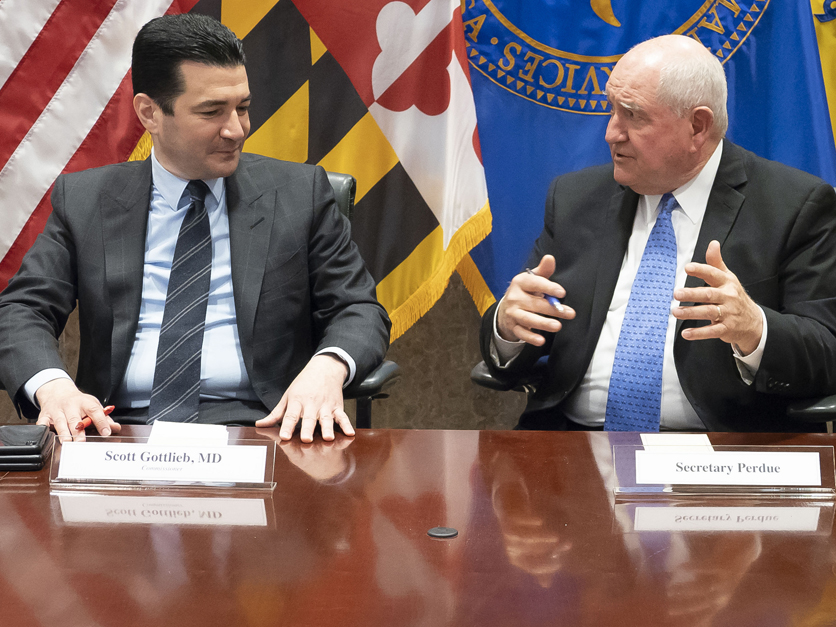USDA and the Food and Drug Administration say they’ve taken a key step in streamlining produce safety requirements for farmers and making oversight of food safety stronger and more efficient.
The two Cabinet agencies, which each play a key role in keeping the U.S. food supply safe, say they’ve aligned USDA’s Harmonized Good Agricultural Practices Audit Program (USDA H-GAP) with the requirements of the FDA Food Safety Modernization Act’s (FSMA’s) Produce Safety Rule.
The announcement was made in conjunction with a town hall meeting at FDA’s White Oak Campus in Silver Spring, Md., featuring FDA Commissioner Scott Gottlieb and Agriculture Secretary Sonny Perdue, with hundreds of FDA employees in attendance.
“Government should make things easier for our customers whenever possible and these important improvements help accomplish that goal,” Perdue said in a news release issued jointly by FDA and USDA. “Specialty crop farmers who take advantage of a USDA Harmonized GAP audit now will have a much greater likelihood of passing a FSMA inspection as well. This means one stop at USDA helps producers meet federal regulatory requirements, deliver the safest food in the world and grow the market for American-grown food. This is an important first step. We look forward to continuing to work with FDA, other government agencies and especially our state partners to ensure proper training of auditors and inspectors, and to help producers understand changes in the audit.”
While the requirements of both programs are not identical, the relevant technical components in the FDA Produce Safety Rule are covered in the USDA H-GAP Audit Program, USDA and FDA said in their release. The aligned components include areas such as biological soil amendments; sprouts; domesticated and wild animals; worker training; health and hygiene; and equipment, tools and buildings. The alignment will help farmers by enabling them to assess their food safety practices as they prepare to comply with the Produce Safety Rule. However, the USDA audits are not a substitute for FDA or state regulatory inspections.
“We’re committed to working with USDA to pursue our shared goal of advancing food safety in a way that is efficient and helps farmers meet our regulatory standards. By working together, our two programs can advance these efforts more effectively,” Gottlieb said. “Today’s announcement will help FDA and states better prioritize our inspectional activities by using USDA H-GAP audit information to prioritize inspectional resources and ultimately enhance our overall ability to protect public health.”
Perdue told reporters after the town hall that farmers are relieved at the alignment of the two standards. He said a Good Agricultural Practices notebook, which helps farmers prepare for an audit, is “about that thick,” holding his thumb and forefinger about three inches apart. He added that farmers spend a lot of time and effort getting ready for audits, and they don’t want to be subjected to similar audits twice.
The Produce Safety Rule, which went into effect in January 2016, establishes science-based minimum standards for the safe growing, harvesting, packing and holding of fruits and vegetables grown for human consumption. Large farming operations were required to comply with the rule in January 2018. However, the FDA had previously announced that inspections to assess compliance with the Produce Safety Rule for produce other than sprouts would not begin until Spring 2019. Small and very small farms have additional time to comply.
The USDA Harmonized GAP Audit Program is an audit developed as part of the Produce GAP Harmonization Initiative, an industry-driven effort to develop food safety GAP standards and audit checklists for pre-harvest and post-harvest operations. The GAP audit is applicable to all fresh produce commodities, all sizes of on-farm operations and all regions in the United States.
Tuesday’s announcement builds on a formal agreement signed earlier this year outlining plans to increase interagency coordination regarding produce safety, inspections of dual-jurisdiction facilities and biotechnology activities. The agencies said they are committed to continuing to work collaboratively to ensure that the requirements and expectations of the USDA H-GAP Audit Program remain aligned with the FDA’s Produce Safety Rule.
For more news, go to www.Agri-Pulse.com


